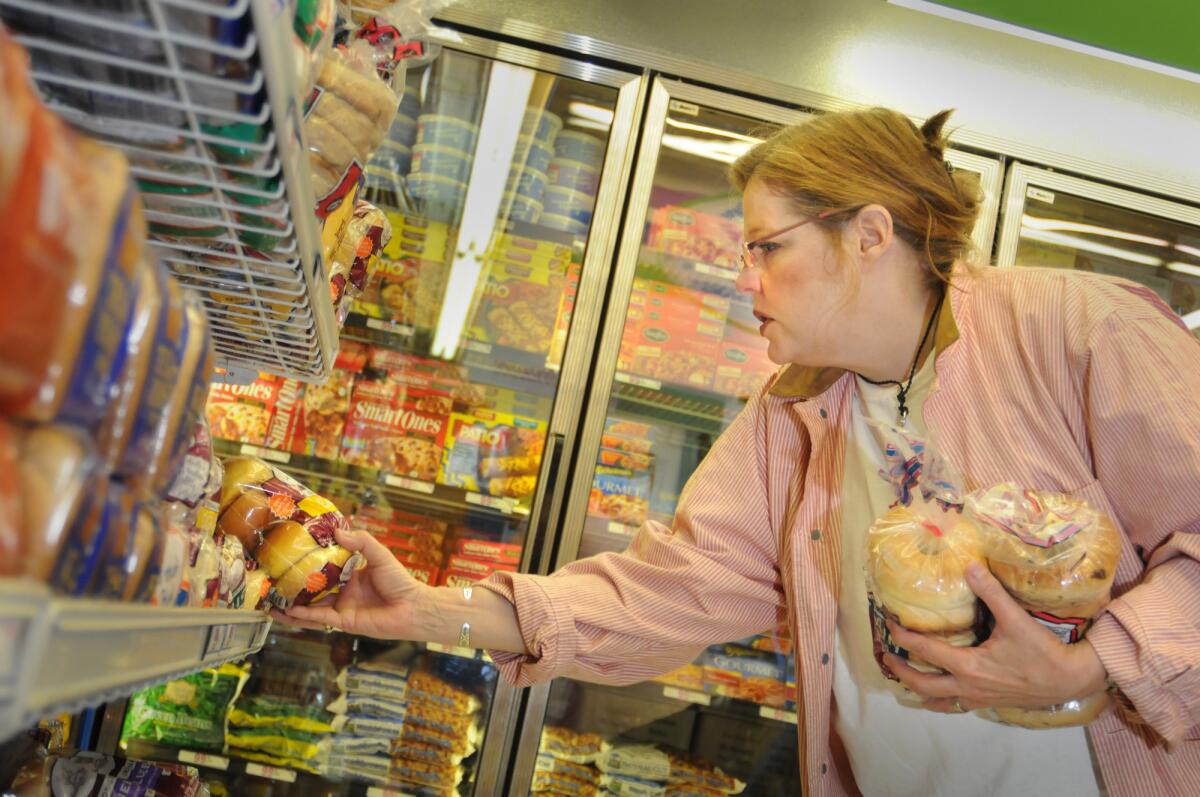What’s wrong with the American diet? More than half our calories come from ‘ultra-processed’ foods

A shopper looks through the bagel selection in a Los Angeles store. Breads, frozen foods and other ultra-processed foods make up 58% of calories eaten by Americans and provide 90% of our added sugars, according to a new study.
Researchers who have analyzed America’s eating habits say they can sum up what’s wrong with our diet in just two words: ultra-processed foods.
These foods -- a group that includes frozen pizzas, breakfast cereals and soda -- make up 58% of all calories Americans consume in a typical day. Not only that, they delivered 90% of the added sugars that Americans ate and drank, according to a study published Wednesday in the medical journal BMJ Open.
See the most-read stories in Science this hour >>
Government health experts advise Americans to get no more than 10% of their total calories in the form of added sugars. But most of us aren’t listening. Researchers from the Centers for Disease Control and Prevention have said that 71% of American adults exceeded that 10% goal, and that added sugars accounted for 15% of all the calories they consumed.
All of that added sugar makes people more likely to be overweight or obese. That, in turn, sets them up for serious health problems like Type 2 diabetes, heart disease, stroke and cancer (not to mention lots of cavities).
More than 75% of the sugar and high-fructose corn syrup eaten by Americans was used by the food industry, according to data from the U.S. Department of Agriculture. So researchers thought it would be a good idea to figure out the extent to which the food industry was feeding America.
To find out, they turned to data collected by the CDC as part of its ongoing National Health and Nutrition Examination Survey, which tracks the eating habits of a nationally representative group of children and adults. The researchers focused on interviews with 9,317 people in 2009 and 2010 who recalled every single thing they had eaten in the previous 24 hours. More than 280,000 food items were named.
The survey-takers consumed 2,070 calories per day, on average. About 28% of those calories came from unprocessed or minimally processed foods, such as eggs, milk, vegetables and fish, and 3.1% from cooking ingredients like table sugar and olive oil. (The amounts were slightly different when the researchers calculated the average for the individual study participants instead of considering the whole group at once: Calories from unprocessed and minimally processed foods made up 30% of a typical person’s diet, and calories from cooking ingredients accounted for 2.9%.) An additional 10% of calories were traced to processed foods, including cheese, canned vegetables and cured meat.
But the caloric contribution of ultra-processed foods was greater than for all other categories combined, accounting for nearly 3 in every 5 calories consumed.
The researchers defined ultra-processed foods as those that used artificial flavors, colors, sweeteners, stabilizers and other additives to make them taste like real food or mask their “undesirable qualities.” Breads, cakes, cookies, pies and salty snacks were the most popular ultra-processed foods, as measured by their contribution to the day’s total calories.
Overall, 14% of all calories could be traced to added sugars, the survey data revealed. But some types of food were sweeter than others.
By definition, unprocessed and minimally processed foods contained no added sugars. Processed foods got 2% of their calories from added sugars, on average. For ultra-processed foods, that figure was 21%.
Not surprisingly, the more ultra-processed foods a person ate, the more likely they were to blow past the 10% added sugar limit. The researchers divided the survey-takers into five equal-sized groups based on their consumption of ultra-processed foods. Among those who ate the least of these foods, added sugar accounted for 7.5% of total calories; among those who ate the most ultra-processed foods, added sugars made up 19.5% of total calories.
The significance of these results is clear, the researchers said: If Americans are ever going to get serious about added sugars, they’ll have to cut way back on ultra-processed foods.
Dr. Carlos A. Monteiro, a professor of nutrition and public health at the University of Sao Paulo in Brazil and the senior author of the report, said he wasn’t too surprised to find that ultra-processed foods were such a huge part of the American diet. A previous study he worked on found that the average American purchased 307 kilograms (about 677 pounds) of ultra-processed foods and drinks in 2013, far more than the culturally similar Canadians (230 kilograms, or 507 pounds) or residents of the United Kingdom (201 kilograms, or 443 pounds).
What did surprise the researchers was that there was so much variation in the amount of ultra-processed foods Americans ate. Though the typical study participant got nearly 60% of his or her calories from ultra-processed foods, one in five got fewer than 30% of their calories that way.
In other words, about 60 million Americans consumed more than 70% of their calories in the form of “real food,” Monteiro said. “This shows that there is hope.”
Follow me on Twitter @LATkarenkaplan and “like” Los Angeles Times Science & Health on Facebook.
Hoy: Léa esta historia en español
See more of our top stories on Facebook >>
MORE IN SCIENCE
How raw meat -- and our ancestors’ inability to chew it -- changed the course of human evolution
Doctors group calls on pediatricians to address child poverty
Stalking wildflowers in the Anza-Borrego desert to forecast the Big Bloom






